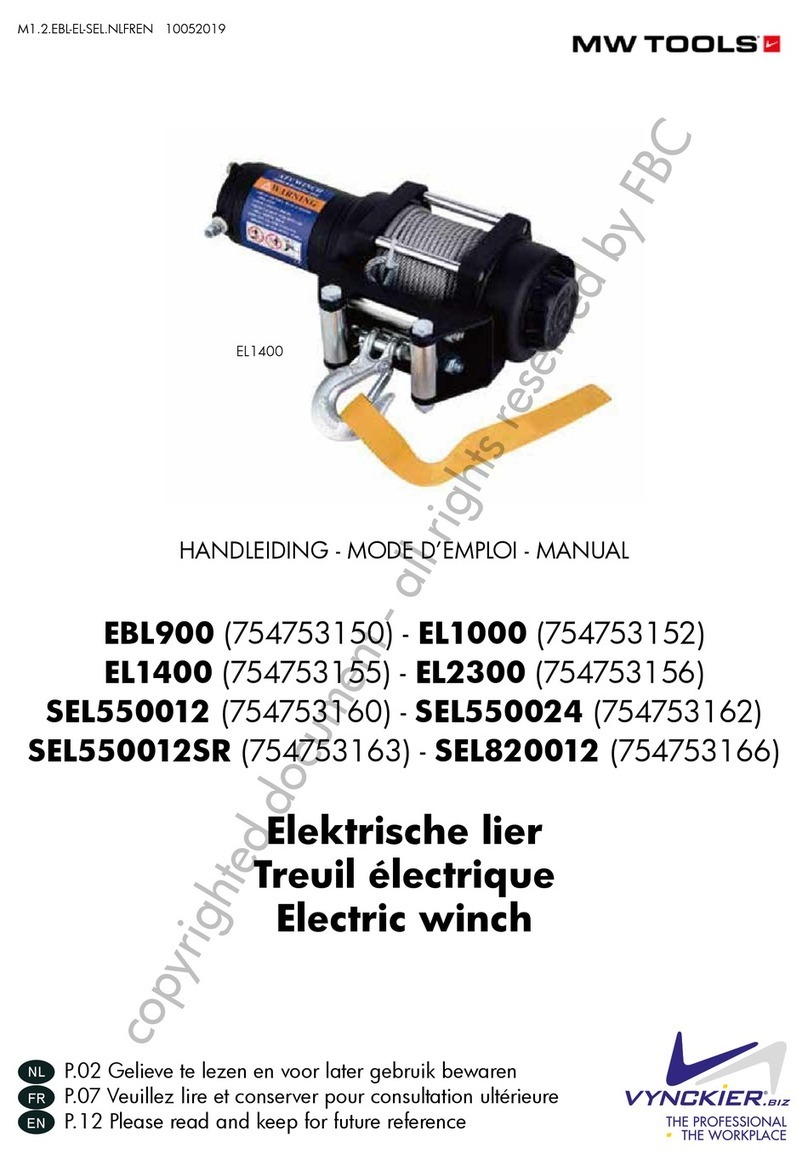
8
FR
M1.1.EBL-EL-SEL.NLFREN 06122018
3 Caractéristiques du produit
• Source d’énergie pratique et portable pour tirer des bateaux, des véhicules bloqués et d’autres objets lourds.
• Grande puissance de traction.
• Alimenté en 12 V ou 24 V pour une utilisation pratique sans rallonges ou petits moteurs à gaz.
• Portable, avec poignée de transport intégrée et plaque de montage rapide
ATTENTION !
Les avertissements, mises en garde et instructions gurant dans ce mode d’emploi ne peuvent pas
couvrir toutes les conditions et situations qui peuvent survenir. L’utilisateur doit comprendre que
le bon sens et la prudence sont des facteurs qui ne peuvent être intégrés à ce produit, mais qui
doivent être fournis par l’utilisateur.
4 Consignes de sécurité
ATTENTION !
Lors de l’utilisation d’un appareil électrique, des précautions de base doivent toujours être prises
pour réduire les risques de blessures et les dangers.
LISEZ TOUTES LES INSTRUCTIONS AVANT D’UTILISER CET OUTIL !
4.1 Consignes de sécurité générales
• Garder la zone de travail propre. Les endroits encombrés peuvent causer des blessures.
• Observer les conditions de l’espace de travail. N’utiliser pas les outils dans des endroits humides, mouillés ou mal éclairés.
N’utiliser pas d’appareils électriques en présence de gaz ou de liquides inammables.
• Gardez les enfants à l’écart et ne les laissez pas manipuler les machines, les outils ou l’équipement.
• Entreposez l’équipement inutilisé. Lorsqu’ils ne sont pas utilisés, les outils doivent être enfermés dans un endroit sec pour
empêcher la rouille. Enfermez toujours les outils et gardez-les hors de portée des enfants.
• Ne forcez pas l’outil. Il fera le travail mieux et de façon plus sûre dans les limites de ses capacités.
• Utilisez l’outil adapté pour chaque travail. N’utilisez pas un outil dans un but autre que celui pour lequel il a été conçu.
• Habillez-vous correctement. Ne portez pas de vêtements amples ou de bijoux, car ils peuvent se prendre dans les pièces
en mouvement. Des chaussures antidérapantes sont recommandées. Attachez les cheveux longs ou portez un let pour les
contenir. Portez toujours des vêtements de travail appropriés.
• Protégez le cordon d’alimentation des dommages causés par les chocs, la traction ou les substances corrosives. Ne tirez
pas sur le câble électrique pour débrancher de la che.
• Ne vous penchez pas trop. Gardez toujours une bonne assise et un bon équilibre.
• Entreteniez les outils avec soin. Suivez les instructions pour lubrier et changer les accessoires. Inspectez périodiquement
le cordon d’alimentation et, s’il est endommagé, faites-le réparer par un électricien qualié. Inspectez toutes les pièces
mobiles et les boulons de xation avant d’utiliser l’appareil.
• Évitez tout démarrage involontaire. Assurez-vous d’être prêt à commencer le travail avant d’actionner l’interrupteur de
démarrage.
• Restez attentif. Faites attention à ce que vous faites. N’utilisez pas cette machine lorsque vous êtes fatigué.
• N’utilisez pas cette machine sous l’inuence de l’alcool, de drogues ou de médicaments pouvant altérer votre capacité de
concentration.
• Vériez que les pièces ne sont pas endommagées. Avant d’utiliser un outil, toute pièce qui semble endommagée doit être
soigneusement vériée pour s’assurer qu’elle fonctionne correctement et qu’elle remplira sa fonction correctement. Vériez
l’alignement des pièces mobiles, contrôlez s’il y a des pièces ou accessoires de montage cassés, ainsi que toute autre
condition qui pourrait affecter le bon fonctionnement. Toute pièce endommagée doit être réparée ou remplacée par un
technicien qualié. N’utilisez pas l’outil si un interrupteur ne s’allume pas ou ne s’éteint pas correctement.
• Pièces de rechange et accessoires. N’utilisez que des pièces de rechange identiques lors de l’entretien. L’utilisation de toute
autre pièce annulera la garantie. N’utilisez que des pièces et accessoires destinés à cet outil, disponibles chez le fabricant.
copyrighted document - all rights reserved by FBC




























